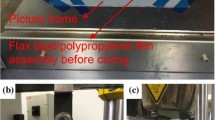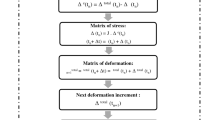Abstract
Flax fibers show potential in bio-efficiency compared to conventional composite fibers with good mechanical properties. The tensile behavior of flax fibers shows a nonlinear stress–strain relation. Within this work, a bilinear elastic–plastic approach is described, which is based on the generalized Hill potential theory and easily applicable in ANSYS. The method was used to model the nonlinear stress–strain behavior under quasi-static tensile loading of flax fiber-reinforced laminates. Hashin failure mechanisms using the stress–strain data of the bilinear model are applied as well. The results were compared to experimental data, carried out using pre-impregnated flax fibers in three types of tensile test specimens. The layups of investigation were \([0]_6\), \([90]_6\) and \([\pm \, 45]_8\). The strain was evaluated using the non-contact, digital image correlation measurement ARAMIS. Good agreement with the test results was achieved, and the method of bilinear elastic–plastic modeling of flax fiber-reinforced structures was evaluated as simple but effective for quasi-static elongation under uniaxial tensile loading.









Similar content being viewed by others
References
Alkbir M, Sapuan S, Nuraini A, Ishak M (2016) Fibre properties and crashworthiness parameters of natural fibre-reinforced composite structure: a literature review. Compos Struct 148:59–73
Anandjiwala R, Blouw S (2007) Composites from bast fibres: prospects and potential in the changing market environment. J Nat Fibers 4(2):91–901
Andersons J, Modniks J, Spārninš E (2015) Modeling the nonlinear deformation of flax-fiber-reinforced polymer matrix laminates in active loading. J Reinf Plast Compos 34:248–256
ANSYS (2009) Theory reference for the mechanical APDL and mechanical applications, Release 12.0, SAS IP, Inc., Canonsburg, PA, USA , pp 71–94
Baley C, Bourmaud A (2014) Average tensile properties of French elementary flax fibers. Mater Lett 122(Supplement C):159–161
Baley C, Perrot Y, Busnel F, Guezenoc H, Davies P (2006) Transverse tensile behaviour of unidirectional plies reinforced with flax fibres. Mater Lett 60:2984–2987
Charlet K, Jernot J, Breard J, Gomina M (2010) Scattering of morphological and mechanical properties of flax fibres. Ind Crops Prod 32:220–224
Charlet K, Jernot J, Gomina M, Bizet L, Bré Ard J (2010) Mechanical properties of flax fibers and of the derived unidirectional composites. J Compos Mater 44:2887–2896
Depuydt D, Hendrickx K, Biesmans W, Ivens J, van Vuure A (2017) Digital image correlation as a strain measurement technique for fibre tensile tests. Compos Part A 99:76–83
Dissanayake NP, Summerscales J, Grove SM, Singh MM (2009) Energy use in the production of flax fiber for the reinforcement of composites. J Nat Fibers 6(4):331–346
Dittenber D, Gangarao H (2012) Critical review of recent publications on use of natural composites in infrastructure. Compos Part A 43:1419–1429
El-Hajjar R, Qamhia I (2013) Modeling and characterization of the moisture-dependent bilinear behavior of regenerated cellulose composites. J Wood Sci 59:331–336
EN2561:1995 (1995) Aerospace series: carbon fibre reinforced plastics: unidirectional laminates. Tensile test parallel to the fibre direction; German Version EN 2561:1995. Deutsches Institut für Normung, Berlin
EN2597:1998 (1998) Aerospace series: carbon fibre reinforced plastics, unidirectional laminates. Tensile test perpendicular to the fibre direction; German version EN 2597:1998. Deutsches Institut für Normung, Berlin
EN6031:2015 (2016) Aerospace series: fibre reinforced plastics: test method—determination of in-plane shear properties (\(\pm 45\) tensile test); German and English version EN 6031:2015
Gilat A, Goldberg RK, Roberts GD (2002) Experimental study of strain-rate-dependent behavior of carbon/epoxy composite. Compos Sci Technol 62:1469–1476
Gning L, Liang S, Guillaumat L, Pui W (2011) Influence of process and test parameters on the mechanical properties of flax/epoxy composites using response surface methodology. J Mater Sci 46:6801–6811. https://doi.org/10.1007/s10853-011-5639-9
GOM mbH (2007) ARAMIS, Benutzerhandbuch-Software, v6, Gesellschaft für Optische Messtechnik mbH, Braunschweig, GER
Hashin Z (1980) Failure criteria for unidirectional fiber composites. J Appl Mech 47:329–334
Hendrickx K, Depuydt D, Van Vuure A, Ivens J (2016) The relationship between the tensile properties of natural fibers and their UD composites. 17th European conference on composite materials, Munich, Germany, 26–30 June 2016
Hill R (1998) The mathematical theory of plasticity. Oxford classic texts in the physical sciences. Clarendon Press, Clarendon
Howarth J, Mareddy SSR, Mativenga PT (2014) Energy intensity and environmental analysis of mechanical recycling of carbon fibre composite. J Clean Prod 81:46–50
Hughes M, Carpenter J, Hill C (2007) Deformation and fracture behaviour of flax fibre reinforced thermosetting polymer matrix composites. J Mater Sci 42:2499–2511. https://doi.org/10.1007/s10853-006-1027-2
Huntsman (2012) Technical data sheet, Araldite® LY 5150*/Aradur® 1571*/Accelerator 1573*/Hardener XB 3471*Prepreg System, Huntsman, Basel, SUI
Kersani M, Lomov S, Willem A, van Vuure A, Ne Bouabdallah A, Verpoest I (2015) Damage in flax/epoxy quasi-unidirectional woven laminates under quasi-static tension. J Compos Mater 49:403–413
Liang S, Gning P, Guillaumat L (2015) Quasi-static behaviour and damage assessment of flax/epoxy composites. Mater Des 67:344–353
Littell J, Ruggeri C, Goldberg R, Roberts G, Arnold W, Binienda W (2008) Measurement of epoxy resin tension, compression, and shear stress–strain curves over a wide range of strain rates using small test specimens. J Aerosp Eng 21(3):162–173
Madsen B (2007) Guidelines for mechanical design with biocomposites: properties, weight and cost. In: JEC Magazine, vol 37
Mahboob Z, Chemisky Y, Meraghni F, Bougherara H (2017) Mesoscale modelling of tensile response and damage evolution in natural fibre reinforced laminates. Compos Part B 119:168–183
Mahboob Z, El Sawi I, Zdero R, Fawaz Z, Bougherara H (2017) Tensile and compressive damaged response in flax fibre reinforced epoxy composites. Compos Part A 92:118–133
Panamoottil S, Das R, Jayaraman K (2016) Anisotropic continuum damage model for prediction of failure in flax/polypropylene fabric composites. Polym Compos 37(8):2588–2597
Pitarresi G, Tumino D, Mancuso A (2015) Thermo-mechanical behaviour of flax-fibre reinforced epoxy laminates for industrial applications. Materials 8(11):7371–7388
Raja T, Anand P, Karthik M, Sundaraj M (2017) Evaluation of mechanical properties of natural fibre reinforced composites: a review. IJMET 8(7):915–924
Rohit K, Dixit S (2016) A review: future aspect of natural fiber reinforced composite. Polym Renew Resour 7(2):43–60
Shah D (2016) Damage in biocomposites: stiffness evolution of aligned plant fibre composites during monotonic and cyclic fatigue loading. Compos Part A 83:160–168
Shah D, Schubel P, Clifford M, Licence P (2012) The tensile behavior of off-axis loaded plant fiber composites: an insight on the nonlinear stress–strain response. Polym Compos 33(9):1494–1504
Shih C, Lee D (1978) Further developments in anisotropic plasticity. J Eng Mater Technol 100:294–302
Valliappan S, Boonlaulohr P, Lee I (1976) Nonlinear analysis for anisotropic materials. Int J Numer Methods Eng 10(3):597–606
Lineo (2015) Technical data sheet-FLAXPREG T-UD, Lineo, Saint Martin du Tilleul, FRA
Wang W, Zhang X, Chouw N, Li Z, Shi Y (2018) Strain rate effect on the dynamic tensile behaviour of flax fibre reinforced polymer. Compos Struct 200:135–143
Weeks CA, Sun CT (1998) Modeling non-linear rate-dependent behavior in fiber-reinforced composites. Compos Sci Technol 58:603–611
Zhong Y, Quan L, Tran N, Kureemun U, Lee H (2017) Prediction of the mechanical behavior of flax polypropylene composites based on multi-scale finite element analysis. J Mater Sci 52:4957–4967. https://doi.org/10.1007/s10853-016-0733-7
Acknowledgements
The work of Josef Steigenberger during the preparation of his Master’s Thesis supported the study in terms of experimental results. The authors also thank Karl-Ludwig Krämer and the team at the LLP machine workshop for their assistance with manufacturing and experimental setup. Additionally, Luicano Avila Gray was a great help giving instructions with the ARAMIS DIC measurement setup and implementation. The project was funded by the Federal Ministry for Economic Affairs and Energy (BMWi) in Germany under the LUFO-V2 funding and the Project No. 20E1501C.
Author information
Authors and Affiliations
Corresponding author
Ethics declarations
Conflict of interest
The authors declare that they have no conflict of interest.
Appendix: Implementation in ANSYS
Appendix: Implementation in ANSYS
The described model is available in commercial ANSYS releases. In this work, the ANSYS 17.2 Workbench version with the Academic Research Mechanical and CFD license was used.
The tensile tests were modeled as surface geometry, where layers were modeled using the ANSYS Composite PrePost (ACP) environment. On the surface geometry of \(150 \times 15\) mm, a mesh of 0.75 mm side length with Hex8 elements was created. In the ACP environment, a rosette was aligned in x to the longitudinal fiber direction, y transversal to the fibers and z pointing in the stack-up thickness direction. For each fiber direction, a different orientation rosette should be used, no matter whether the material properties are the same or not. The ACP environment creates a solid element model from the surface geometry by extruding the layers in thickness direction, the model is then exported to a transient structural analysis. The imported model consists of one element per layer in thickness direction, with side dimensions of the surface mesh. Such layered composites have a side-length proportion which is prone to locking; this should be considered when applied to bending problems.
With command snippets, the imported materials, layers and coordinate systems can be reviewed in the imported geometry part (PREP7). The element type was here set to SOLID45.
In the analysis part (SOLUTION), the material characteristics are defined, overwriting the initial elastic moduli, Poisson’s ratios and shear moduli for each material. For the xy- and xz-directions, it should be distinguished between the major and minor Poisson’s ratio (PRXY and NUXY in ANSYS). Then, the bilinear anisotropic plasticity approach needs the TB, ANISO command to define the nine yield stresses and tangential moduli. The set initial and tangential moduli are equal for tensile \(()_{\mathrm{t}}\) and compressive loads \(()_{\mathrm{c}}\). Qualitatively, the curves (Fig. 4) show similar shape of respective experimental results [26, 29, 30].
The load was applied by a linear displacement in x-direction at the one end. Therefore, the strain in load direction should be linear as well. The displacement was done in the transient analysis over 20 s with equally distributed time steps of 0.5 s.
For the analysis, the elements in the middle part of the specimen with x-coordinates between 65 and 85 mm and y-coordinates between 5 and 10 mm were evaluated in order to neglect the influence of boundary conditions. The user-defined results were used to show the tensile response, SX as stress in the load direction, versus EPTOX and EPTOY to show strains in longitudinal and transversal directions (see Figs. 7, 8, 9). For the failure criteria, the top layer was selected and the fiber-coordinate system was used.
The EPTO command as user-defined result gives the sum of the elastic, plastic and creep strains. For more detailed analysis, the EPPL and EPEL commands can be used, referring to either plastic or elastic strains.
Rights and permissions
About this article
Cite this article
Strohrmann, K., Hajek, M. Bilinear approach to tensile properties of flax composites in finite element analyses. J Mater Sci 54, 1409–1421 (2019). https://doi.org/10.1007/s10853-018-2912-1
Received:
Accepted:
Published:
Issue Date:
DOI: https://doi.org/10.1007/s10853-018-2912-1




